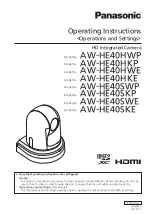
OPERATING AND USER MANUAL Q-12 CoaXPress series
________________________________________________________________________________________________________________
_________________________________________________________________________________________
Adimec
34
7.6.10 ExposureMode
| RW | B |
The camera can be operated in 5 exposure modes. Refer to Figure 7-4 for a description of these modes.
Timed
Free run mode. The camera is master: frame period and integration time
are both fixed and controllable via the AcquisitionFramePeriod feature and
ExposureTime feature respectively.
TriggerWidth
Camera is slave; In this mode an external trigger starts integration. The
integration time is determined by the duration of the trigger pulse.
SyncControlMode
Camera is slave: In sync control mode the acquisition is controlled by the
active edge of the input signal. The inactive edge does not trigger any
event. The active edge is programmable; rising or falling. The integration
time is targeted to be equal to the frame period, however due to the time
required for initiating frame output (Frame Overhead Time/FOT) the
integration time will always be slightly shorter than the frame period.
ISSUE 2 NOTE:
If acquisition is started, the first trigger pulse will output an
image (the first integration time is directly initiated). Note that in general this
results in an image from which the integration time is unknown.
TimedTriggerControl
Camera is slave: Start of integration time is determined by the start of the
trigger, the integration time is fixed and can be controlled via the
ExposureTime feature.
TimedSync
Camera is slave but timing should be synchronized with internal camera
timing. In this exposure mode the frame sequence is synchronized to the
edge of the external trigger signal.
Characteristics:
-
The
AcquisitionFramePeriod
must be set slightly smaller than the
external sync period time. (Take into account that the absolute
camera timing has a deviation of ±120 ppm).
-
When locked the camera frame rate equals the applied external
sync signal frequency.
Acquisition must be stopped when changing the ExposureMode.
7.6.10.1 Exposure time and Frame Overhead Time
CMOS sensors require a certain time after the requested integration time is finished before they can start with
the readout process. This additional time is called the Frame Overhead Time (FOT). The FOT consists of a
period during which the sensor remains light sensitive and a period in which the sensor is not light sensitive
anymore. Especially the light sensitive FOT time is often important to take into account in applications.
The light sensitive FOT time is a fixed value. It only changes with the SensorBitDepth setting. The duration of
this light sensitive FOT time for the available SensorBitDepth settings is listed in Table 7-5. The non light
sensitive FOT time depends on the camera configuration in a more complex way. Therefore in issue 2 cameras
it is possible to read-out the actual FOT time with the FrameOverheadTime feature (section 7.10.3). This feature
is especially useful for the SyncControlMode as it influences the maximum integration time as indicated in
Table 7-6.
During the FOT it is not allowed to sent an acquisition start trigger.
Figure 7-5 and Figure 7-6 show an example of how the FOT time influences the timing in the TriggerWidth and
SyncControlMode. While for the TriggerWidth only the light sensitive FOT (t_sens) influences the integration
time, for the SyncControlMode the whole FOT time influences the integration time.
















































